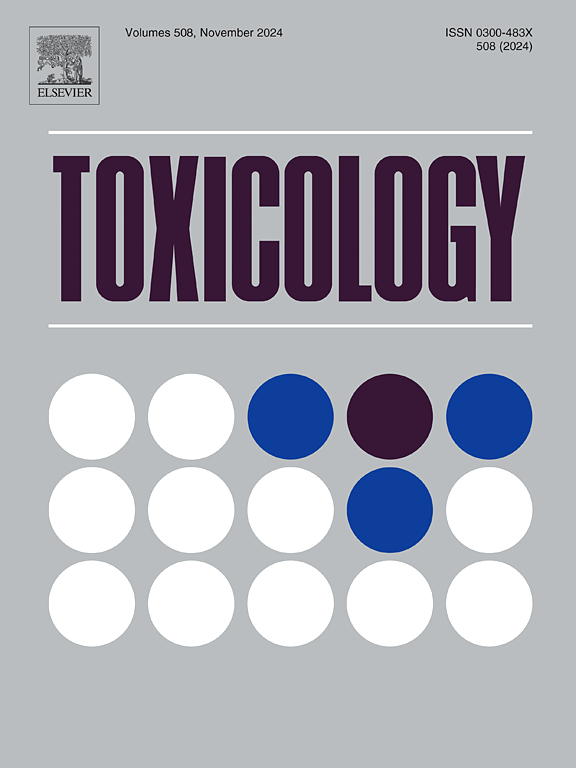在SH-SY5Y/U251共培养模型中,EAAT2功能障碍介导丙烯酰胺诱导的兴奋毒性和神经元损伤
IF 4.6
3区 医学
Q1 PHARMACOLOGY & PHARMACY
引用次数: 0
摘要
丙烯酰胺(ACR)是一种普遍存在的环境和工作场所污染物,具有神经毒性作用,但致病机制尚不清楚。在这项研究中,我们筛选了与神经毒性相关的潜在ACR结合靶点,并确定了星形细胞谷氨酸转运蛋白EAAT2。分子对接和动力学模拟表明,ACR与EAAT2的谷氨酸结合袋稳定地相互作用,可能损害转运功能。将SH-SY5Y人神经母细胞瘤细胞暴露于ACR(0-500 μg/mL) 1、3或5天后,确实观察到EAAT2表达显著降低。同时,它诱导了活细胞数量的显著时间和剂量依赖性减少,Tau磷酸化(AT8, pS396, pS262)的增加,不溶性Tau寡聚物的积累,以及神经营养信号因子BDNF和TrkB的下调。此外,在成熟SY5Y细胞和U251星形胶质细胞的transwell共培养中,ACR(111 μg/mL, 72 h)可导致星形胶质细胞的反应性转化、细胞外谷氨酸积累和通过突触外NMDA受体增强神经元钙内流。这导致下游神经毒性反应,包括BDNF/TrkB抑制、caspase-3激活、Tau过度磷酸化和继发性神经元损伤。星形胶质细胞过表达SLC1A2 (EAAT2)可显著逆转所有这些致病反应。综上所述,这些发现表明,ACR通过干扰星形细胞eaat2介导的细胞外谷氨酸调节诱导神经元兴奋性毒性,导致突触外NMDAR过度激活、细胞内钙超载和tau相关神经变性。EAAT2是缓解acr诱导的神经毒性和相关后遗症(如认知障碍)的潜在治疗靶点。本文章由计算机程序翻译,如有差异,请以英文原文为准。
EAAT2 dysfunction mediates acrylamide-induced excitotoxicity and neuronal damage in a SH-SY5Y/U251 co-culture model
Acrylamide (ACR) is a pervasive environmental and workplace contaminant with established neurotoxic effects but unclear pathogenic mechanisms. In this study, we screened for potential ACR binding targets associated with neurotoxicity and identified the astrocytic glutamate transporter EAAT2. Molecular docking and dynamics simulations revealed that ACR interacts stably with the glutamate-binding pocket of EAAT2, potentially impairing transport function. After exposing SH-SY5Y human neuroblastoma cells to ACR (0–500 μg/mL) for 1, 3, or 5 days, a significant decrease in EAAT2 expression was indeed observed. Concurrently, it induced significant time- and dose-dependent reductions in viable cell numbers, increases in Tau phosphorylation (AT8, pS396, pS262), and the accumulation of insoluble Tau oligomers, as well as the downregulation of neurotrophic signaling factors BDNF and TrkB. Moreover, in transwell co-cultures of mature SY5Y cells and U251 astrocytes, ACR administration (111 μg/mL, 72 h) resulted in reactive transformation of astrocytes, extracellular glutamate accumulation and enhanced neuronal calcium influx via extrasynaptic NMDA receptors. This resulted in downstream neurotoxic responses including BDNF/TrkB suppression, caspase-3 activation, Tau hyperphosphorylation and secondary neuronal injury. Astrocytic overexpression of SLC1A2 (EAAT2) significantly reversed all of these pathogenic responses. Taken together, these findings suggest that ACR induces neuronal excitotoxicity by interfering with astrocytic EAAT2-mediated regulation of extracellular glutamate, leading to extrasynaptic NMDAR overactivation, intracellular calcium overload, and Tau-related neurodegeneration. The EAAT2 is a potential therapeutic target for mitigating ACR-induced neurotoxicity and associated sequelae such as cognitive impairment.
求助全文
通过发布文献求助,成功后即可免费获取论文全文。
去求助
来源期刊

Toxicology
医学-毒理学
CiteScore
7.80
自引率
4.40%
发文量
222
审稿时长
23 days
期刊介绍:
Toxicology is an international, peer-reviewed journal that publishes only the highest quality original scientific research and critical reviews describing hypothesis-based investigations into mechanisms of toxicity associated with exposures to xenobiotic chemicals, particularly as it relates to human health. In this respect "mechanisms" is defined on both the macro (e.g. physiological, biological, kinetic, species, sex, etc.) and molecular (genomic, transcriptomic, metabolic, etc.) scale. Emphasis is placed on findings that identify novel hazards and that can be extrapolated to exposures and mechanisms that are relevant to estimating human risk. Toxicology also publishes brief communications, personal commentaries and opinion articles, as well as concise expert reviews on contemporary topics. All research and review articles published in Toxicology are subject to rigorous peer review. Authors are asked to contact the Editor-in-Chief prior to submitting review articles or commentaries for consideration for publication in Toxicology.
 求助内容:
求助内容: 应助结果提醒方式:
应助结果提醒方式:


